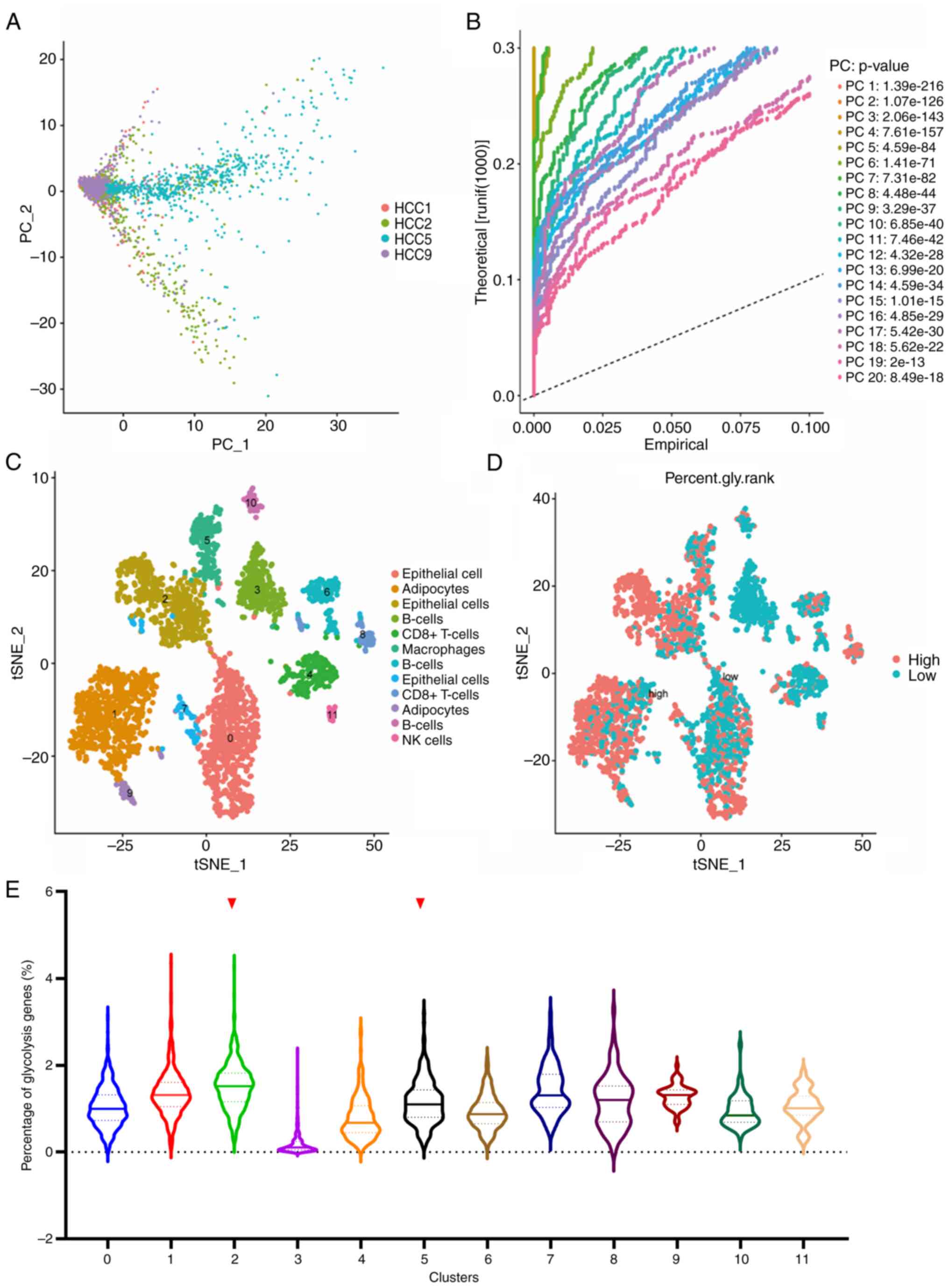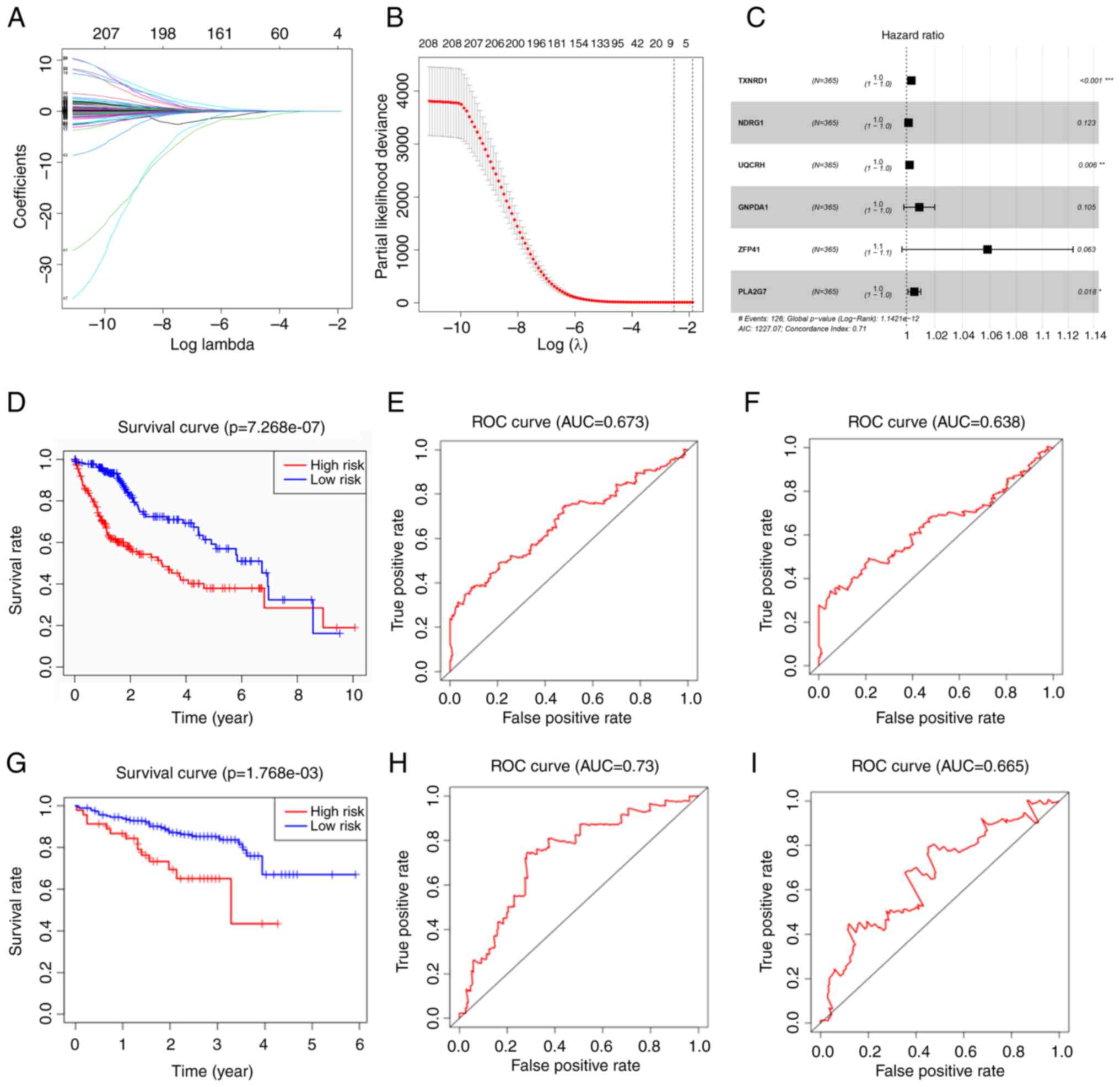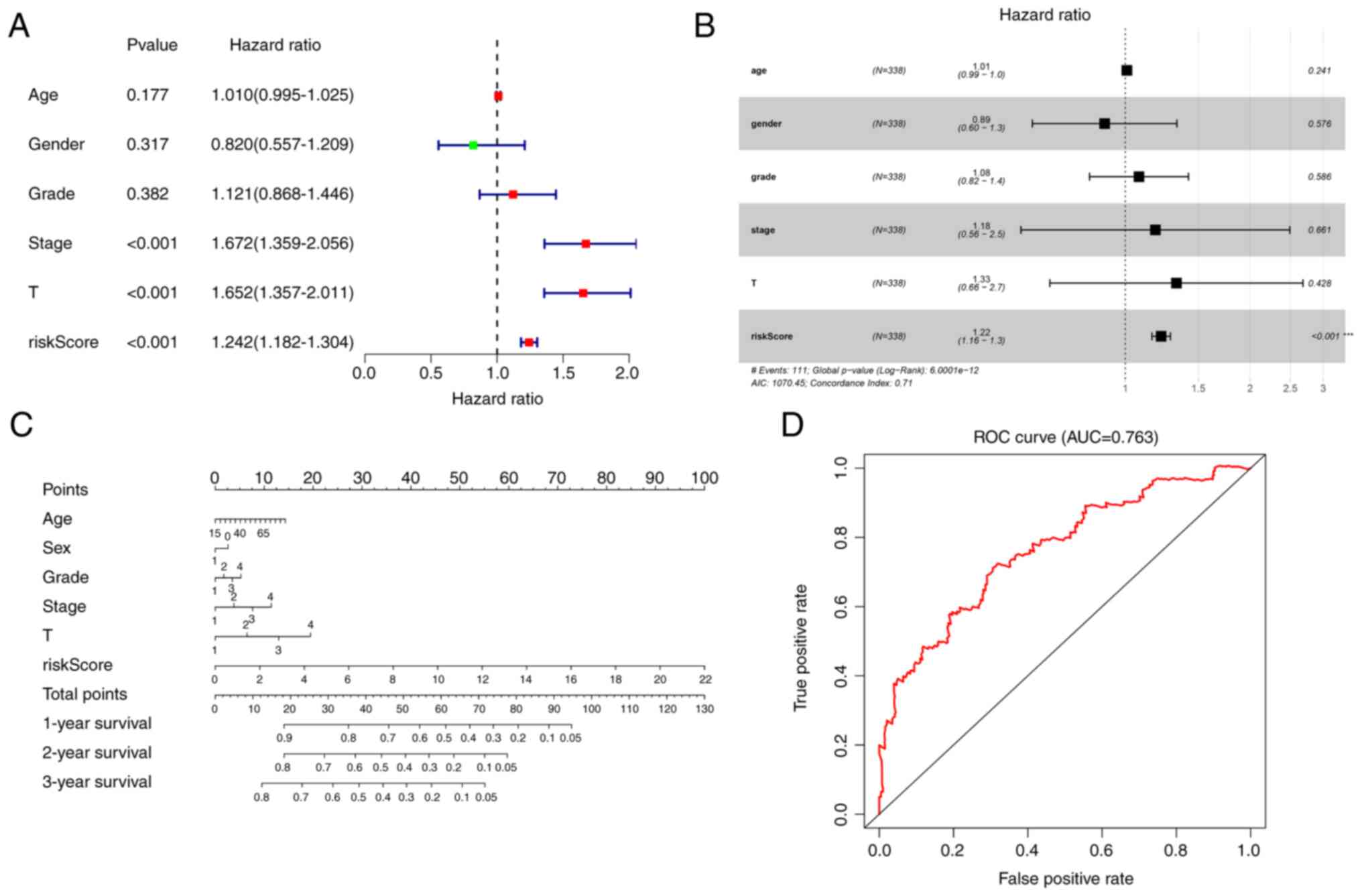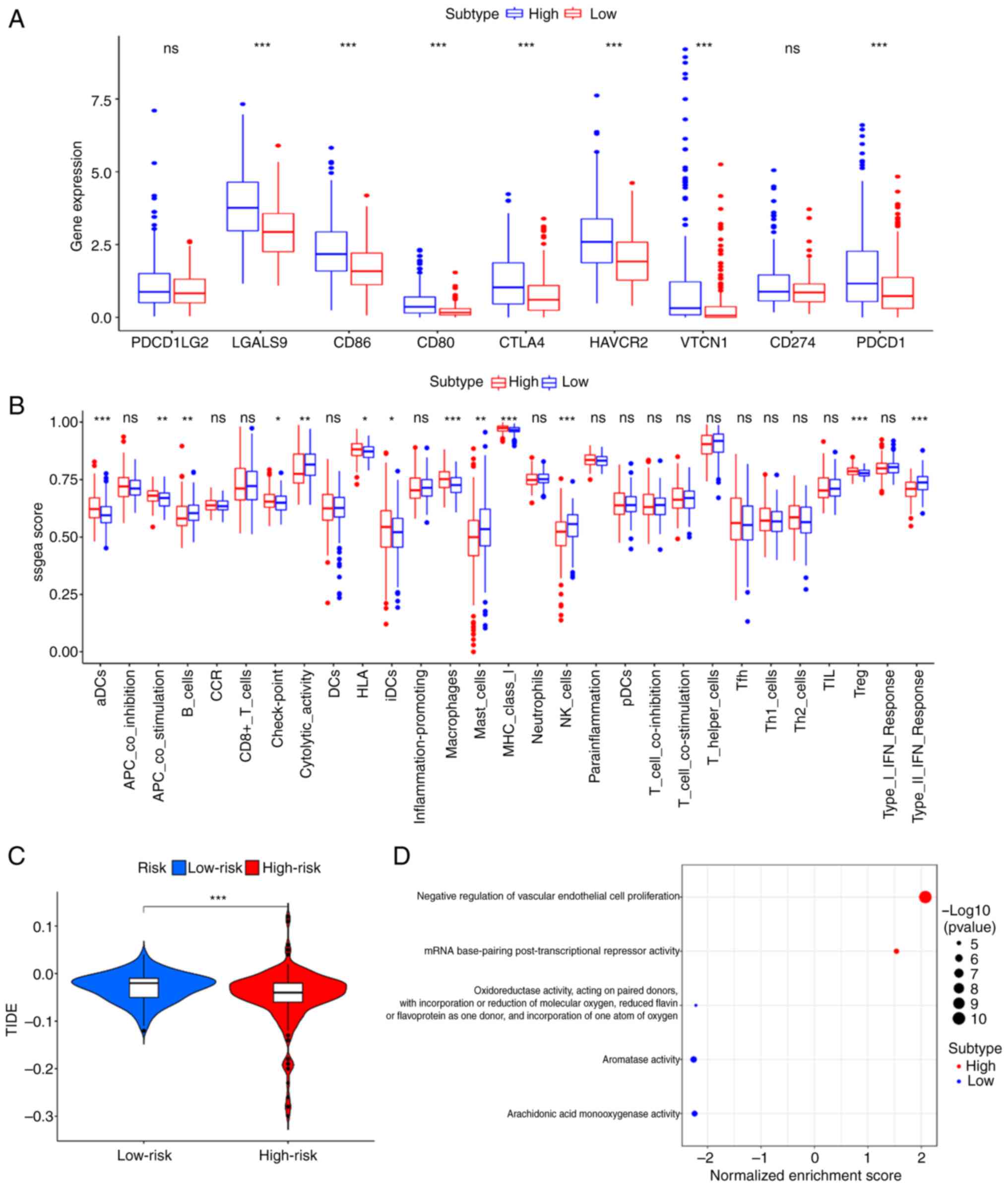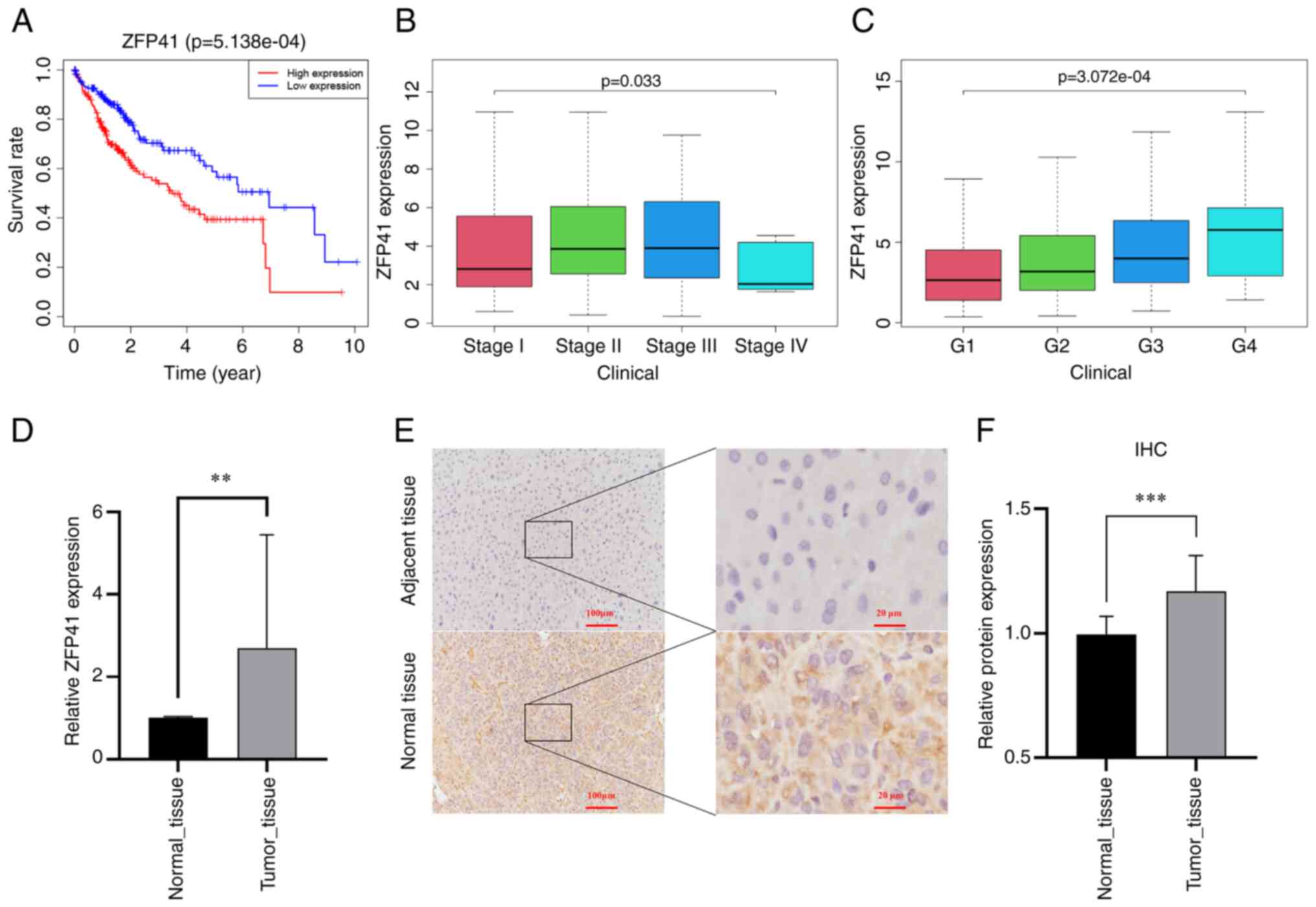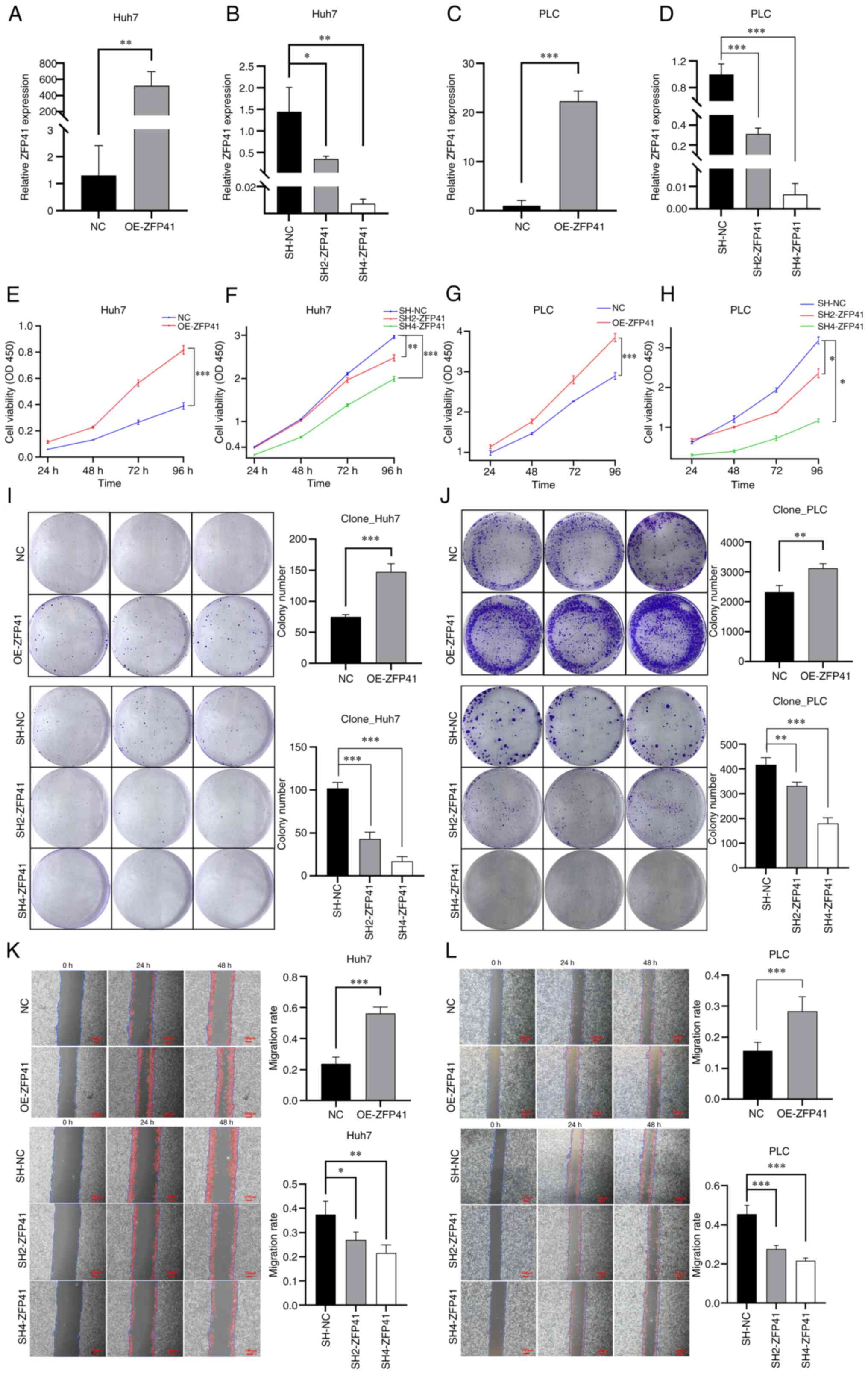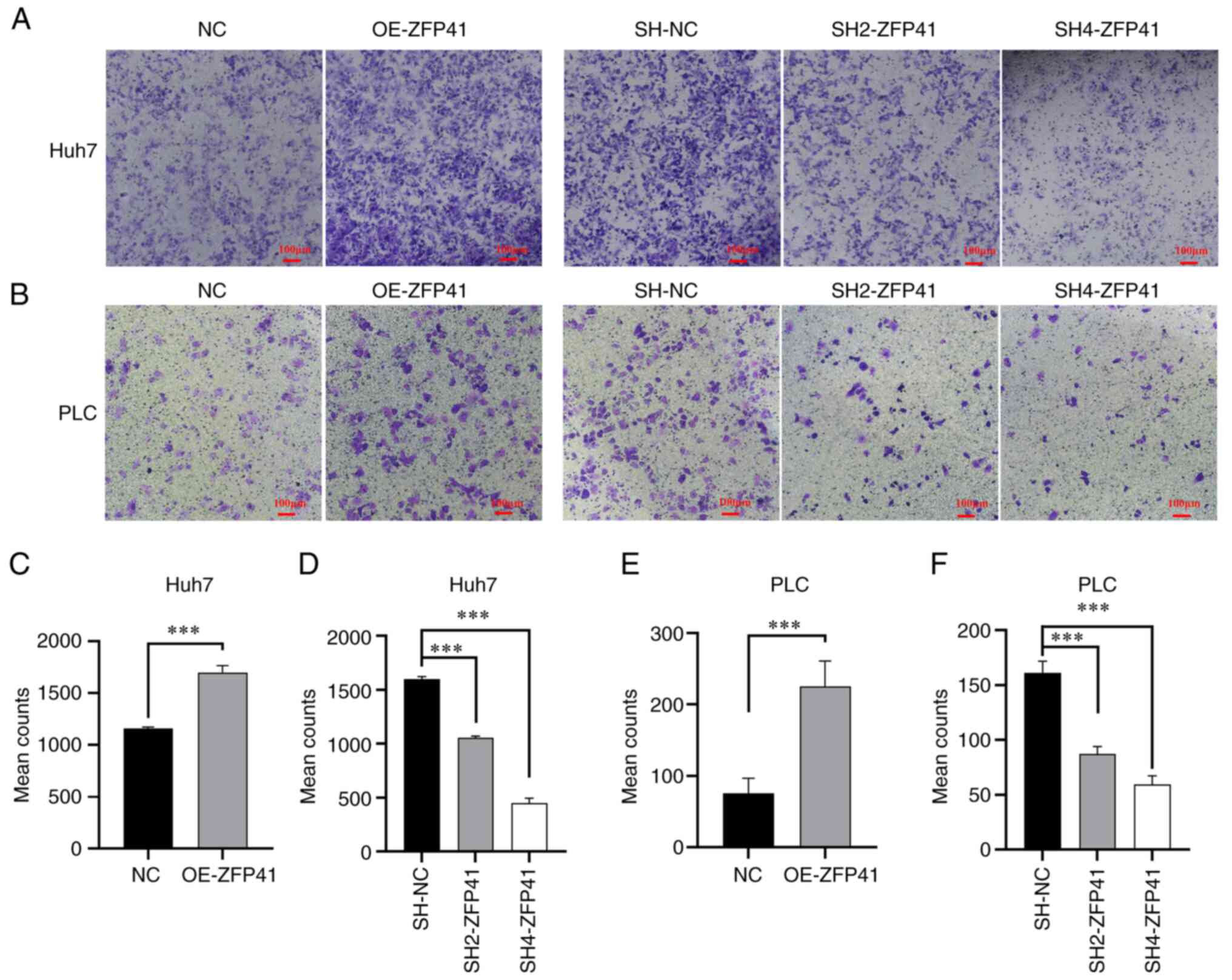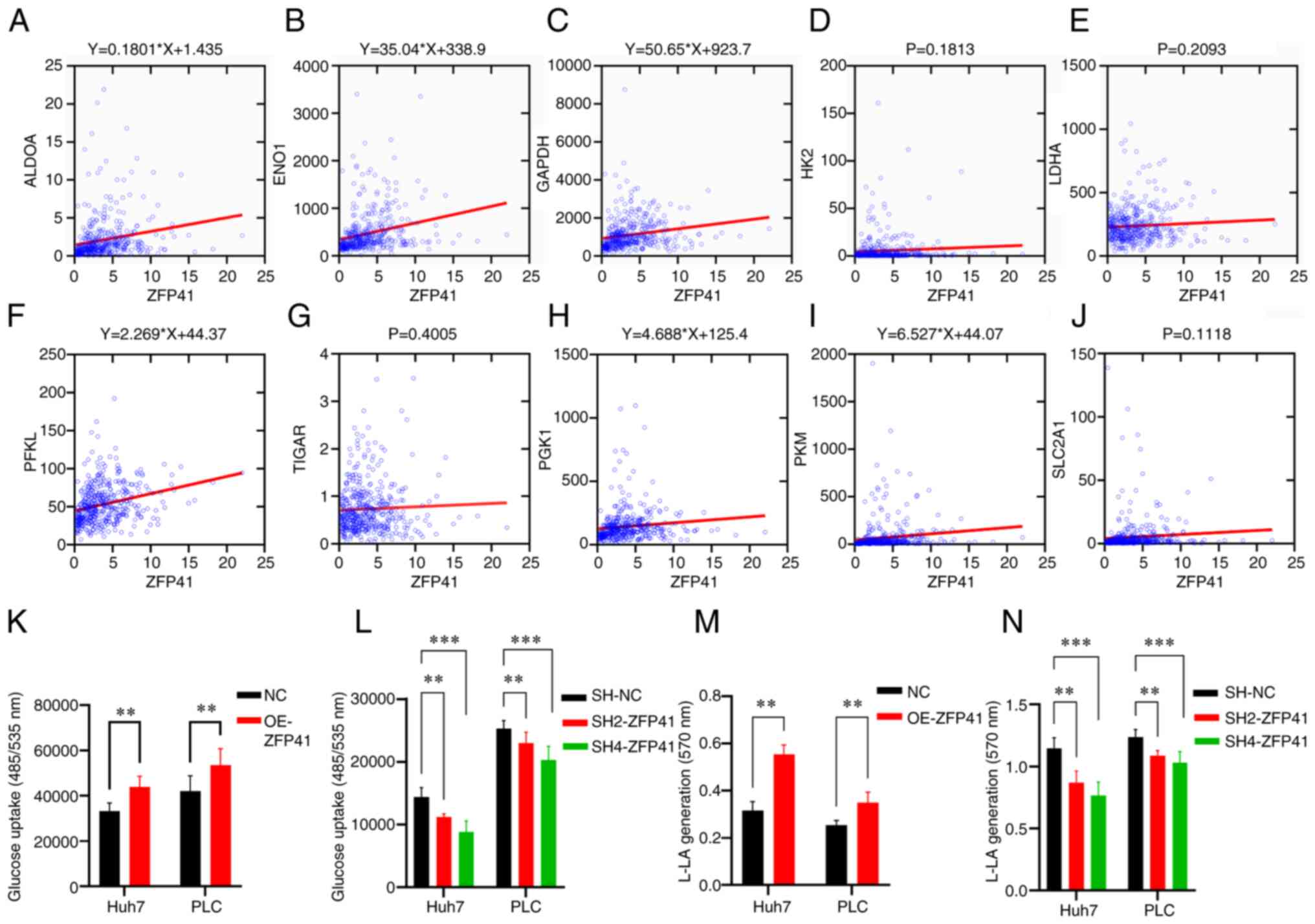|
1
|
Llovet JM, Kelley RK, Villanueva A, Singal
AG, Pikarsky E, Roayaie S, Lencioni R, Koike K, Zucman-Rossi J and
Finn RS: Hepatocellular carcinoma. Nat Rev Dis Primers. 7:62021.
View Article : Google Scholar : PubMed/NCBI
|
|
2
|
McGlynn KA, Petrick JL and El-Serag HB:
Epidemiology of hepatocellular carcinoma. Hepatology. 73 (Suppl
1):S4–S13. 2021. View Article : Google Scholar
|
|
3
|
Llovet JM, Pinyol R, Kelley RK,
El-Khoueiry A, Reeves HL, Wang XW, Gores GJ and Villanueva A:
Molecular pathogenesis and systemic therapies for hepatocellular
carcinoma. Nat Cancer. 3:386–401. 2022. View Article : Google Scholar : PubMed/NCBI
|
|
4
|
Feng J, Li J, Wu L, Yu Q, Ji J, Wu J, Dai
W and Guo C: Emerging roles and the regulation of aerobic
glycolysis in hepatocellular carcinoma. J Exp Clin Cancer Res.
39:1262020. View Article : Google Scholar : PubMed/NCBI
|
|
5
|
Du D, Liu C, Qin M, Zhang X, Xi T, Yuan S,
Hao H and Xiong J: Metabolic dysregulation and emerging
therapeutical targets for hepatocellular carcinoma. Acta Pharm Sin
B. 12:558–580. 2022. View Article : Google Scholar : PubMed/NCBI
|
|
6
|
Zhang Y, Zhai Z, Duan J, Wang X, Zhong J,
Wu L, Li A, Cao M, Wu Y, Shi H, et al: Lactate: The mediator of
metabolism and immunosuppression. Front Endocrinol (Lausanne).
13:9014952022. View Article : Google Scholar : PubMed/NCBI
|
|
7
|
Zhang QY, Ho DW, Tsui YM and Ng IO:
Single-cell transcriptomics of liver cancer: Hype or insights? Cell
Mol Gastroenterol Hepatol. 14:513–525. 2022. View Article : Google Scholar : PubMed/NCBI
|
|
8
|
Aliya S, Lee H, Alhammadi M, Umapathi R
and Huh YS: An overview on single-cell technology for
hepatocellular carcinoma diagnosis. Int J Mol Sci. 23:14022022.
View Article : Google Scholar : PubMed/NCBI
|
|
9
|
Zhang Y, Wang D, Peng M, Tang L, Ouyang J,
Xiong F, Guo C, Tang Y, Zhou Y, Liao Q, et al: Single-cell RNA
sequencing in cancer research. J Exp Clin Cancer Res. 40:812021.
View Article : Google Scholar : PubMed/NCBI
|
|
10
|
Lei Y, Tang R, Xu J, Wang W, Zhang B, Liu
J, Yu X and Shi S: Applications of single-cell sequencing in cancer
research: Progress and perspectives. J Hematol Oncol. 14:912021.
View Article : Google Scholar : PubMed/NCBI
|
|
11
|
Martens JH and Stunnenberg HG: BLUEPRINT:
Mapping human blood cell epigenomes. Haematologica. 98:1487–1489.
2013. View Article : Google Scholar : PubMed/NCBI
|
|
12
|
ENCODE Project Consortium, . An integrated
encyclopedia of DNA elements in the human genome. Nature.
489:57–74. 2012. View Article : Google Scholar : PubMed/NCBI
|
|
13
|
Mabbott NA, Baillie JK, Brown H, Freeman
TC and Hume DA: An expression atlas of human primary cells:
Inference of gene function from coexpression networks. BMC
Genomics. 14:6322013. View Article : Google Scholar : PubMed/NCBI
|
|
14
|
Schmiedel BJ, Singh D, Madrigal A,
Valdovino-Gonzalez AG, White BM, Zapardiel-Gonzalo J, Ha B, Altay
G, Greenbaum JA, McVicker G, et al: Impact of genetic polymorphisms
on human immune cell gene expression. Cell. 175:1701–15.e16. 2018.
View Article : Google Scholar : PubMed/NCBI
|
|
15
|
Livak KJ and Schmittgen TD: Analysis of
relative gene expression data using real-time quantitative PCR and
the 2(−Delta Delta C(T)) method. Methods. 25:402–408. 2001.
View Article : Google Scholar : PubMed/NCBI
|
|
16
|
Brown ZJ, Tsilimigras DI, Ruff SM, Mohseni
A, Kamel IR, Cloyd JM and Pawlik TM: Management of hepatocellular
carcinoma: A review. JAMA Surg. 158:410–420. 2023. View Article : Google Scholar : PubMed/NCBI
|
|
17
|
Wen N, Cai Y, Li F, Ye H, Tang W, Song P
and Cheng N: The clinical management of hepatocellular carcinoma
worldwide: A concise review and comparison of current guidelines:
2022 Update. Biosci Trends. 16:20–30. 2022. View Article : Google Scholar : PubMed/NCBI
|
|
18
|
Chidambaranathan-Reghupaty S, Fisher PB
and Sarkar D: Hepatocellular carcinoma (HCC): Epidemiology,
etiology and molecular classification. Adv Cancer Res. 149:1–61.
2021. View Article : Google Scholar : PubMed/NCBI
|
|
19
|
Vogel A, Meyer T, Sapisochin G, Salem R
and Saborowski A: Hepatocellular carcinoma. Lancet. 400:1345–1362.
2022. View Article : Google Scholar : PubMed/NCBI
|
|
20
|
Zhang Q, Lou Y, Yang J, Wang J, Feng J,
Zhao Y, Wang L, Huang X, Fu Q, Ye M, et al: Integrated multiomic
analysis reveals comprehensive tumour heterogeneity and novel
immunophenotypic classification in hepatocellular carcinomas. Gut.
68:2019–2031. 2019. View Article : Google Scholar : PubMed/NCBI
|
|
21
|
Sperandio RC, Pestana RC, Miyamura BV and
Kaseb AO: Hepatocellular carcinoma immunotherapy. Annu Rev Med.
73:267–278. 2022. View Article : Google Scholar : PubMed/NCBI
|
|
22
|
Liu Z, Liu X, Liang J, Liu Y, Hou X, Zhang
M, Li Y and Jiang X: Immunotherapy for hepatocellular carcinoma:
Current status and future prospects. Front Immunol. 12:7651012021.
View Article : Google Scholar : PubMed/NCBI
|
|
23
|
Jiang Y, Han QJ and Zhang J:
Hepatocellular carcinoma: Mechanisms of progression and
immunotherapy. World J Gastroenterol. 25:3151–3167. 2019.
View Article : Google Scholar : PubMed/NCBI
|
|
24
|
Chen L, Huang L, Gu Y, Cang W, Sun P and
Xiang Y: Lactate-lactylation hands between metabolic reprogramming
and immunosuppression. Int J Mol Sci. 23:119432022. View Article : Google Scholar : PubMed/NCBI
|
|
25
|
Ganapathy-Kanniappan S: Linking tumor
glycolysis and immune evasion in cancer: Emerging concepts and
therapeutic opportunities. Biochim Biophys Acta Rev Cancer.
1868:212–220. 2017. View Article : Google Scholar : PubMed/NCBI
|
|
26
|
Ganapathy-Kanniappan S and Geschwind JF:
Tumor glycolysis as a target for cancer therapy: Progress and
prospects. Mol Cancer. 12:1522013. View Article : Google Scholar : PubMed/NCBI
|
|
27
|
Su X, Zhao L, Shi Y, Zhang R, Long Q, Bai
S, Luo Q, Lin Y, Zou X, Ghazanfar S, et al: Clonal evolution in
liver cancer at single-cell and single-variant resolution. J
Hematol Oncol. 14:222021. View Article : Google Scholar : PubMed/NCBI
|
|
28
|
Li Y, Song Z, Han Q, Zhao H, Pan Z, Lei Z
and Zhang J: Targeted inhibition of STAT3 induces immunogenic cell
death of hepatocellular carcinoma cells via glycolysis. Mol Oncol.
16:2861–2880. 2022. View Article : Google Scholar : PubMed/NCBI
|
|
29
|
Matsumoto K, Noda T, Kobayashi S, Sakano
Y, Yokota Y, Iwagami Y, Yamada D, Tomimaru Y, Akita H, Gotoh K, et
al: Inhibition of glycolytic activator PFKFB3 suppresses tumor
growth and induces tumor vessel normalization in hepatocellular
carcinoma. Cancer Lett. 500:29–40. 2021. View Article : Google Scholar : PubMed/NCBI
|
|
30
|
Chen DP, Ning WR, Jiang ZZ, Peng ZP, Zhu
LY, Zhuang SM, Kuang DM, Zheng L and Wu Y: Glycolytic activation of
peritumoral monocytes fosters immune privilege via the PFKFB3-PD-L1
axis in human hepatocellular carcinoma. J Hepatol. 71:333–343.
2019. View Article : Google Scholar : PubMed/NCBI
|
|
31
|
Suthen S, Lim CJ, Nguyen PHD, Dutertre CA,
Lai HLH, Wasser M, Chua C, Lim TKH, Leow WQ, Loh TJ, et al:
Hypoxia-driven immunosuppression by Treg and type-2 conventional
dendritic cells in HCC. Hepatology. 76:1329–1344. 2022. View Article : Google Scholar : PubMed/NCBI
|
|
32
|
Lu LG, Zhou ZL, Wang XY, Liu BY, Lu JY,
Liu S, Zhang GB, Zhan MX and Chen Y: PD-L1 blockade liberates
intrinsic antitumourigenic properties of glycolytic macrophages in
hepatocellular carcinoma. Gut. 71:2551–2560. 2022. View Article : Google Scholar : PubMed/NCBI
|
|
33
|
Cheng K, Cai N, Zhu J, Yang X, Liang H and
Zhang W: Tumor-associated macrophages in liver cancer: From
mechanisms to therapy. Cancer Commun (Lond). 42:1112–1140. 2022.
View Article : Google Scholar : PubMed/NCBI
|
|
34
|
Wculek SK, Cueto FJ, Mujal AM, Melero I,
Krummel MF and Sancho D: Dendritic cells in cancer immunology and
immunotherapy. Nat Rev Immunol. 20:7–24. 2020. View Article : Google Scholar : PubMed/NCBI
|
|
35
|
Xu F, Jin T, Zhu Y and Dai C: Immune
checkpoint therapy in liver cancer. J Exp Clin Cancer Res.
37:1102018. View Article : Google Scholar : PubMed/NCBI
|
|
36
|
Huang CF, Huang CY, Yeh ML, Wang SC, Chen
KY, Ko YM, Lin CC, Tsai YS, Tsai PC, Lin ZY, et al: Genetics
variants and serum levels of MHC class I chain-related A in
predicting hepatocellular carcinoma development in chronic
hepatitis C patients post antiviral treatment. EBioMedicine.
15:81–89. 2017. View Article : Google Scholar : PubMed/NCBI
|
|
37
|
Sajid M, Liu L and Sun C: The dynamic role
of NK cells in liver cancers: Role in HCC and HBV associated HCC
and its therapeutic implications. Front Immunol. 13:8871862022.
View Article : Google Scholar : PubMed/NCBI
|
|
38
|
Garnelo M, Tan A, Her Z, Yeong J, Lim CJ,
Chen J, Lim KH, Weber A, Chow P, Chung A, et al: Interaction
between tumour-infiltrating B cells and T cells controls the
progression of hepatocellular carcinoma. Gut. 66:342–351. 2017.
View Article : Google Scholar : PubMed/NCBI
|
|
39
|
Dunn GP, Koebel CM and Schreiber RD:
Interferons, immunity and cancer immunoediting. Nat Rev Immunol.
6:836–848. 2006. View Article : Google Scholar : PubMed/NCBI
|
|
40
|
Donne R and Lujambio A: The liver cancer
immune microenvironment: Therapeutic implications for
hepatocellular carcinoma. Hepatology. 77:1773–1796. 2023.
View Article : Google Scholar : PubMed/NCBI
|
|
41
|
Fu J, Li K, Zhang W, Wan C, Zhang J, Jiang
P and Liu XS: Large-scale public data reuse to model immunotherapy
response and resistance. Genome Med. 12:212020. View Article : Google Scholar : PubMed/NCBI
|
|
42
|
Cappellesso F, Orban MP, Shirgaonkar N,
Berardi E, Serneels J, Neveu MA, Di Molfetta D, Piccapane F,
Caroppo R, Debellis L, et al: Targeting the bicarbonate transporter
SLC4A4 overcomes immunosuppression and immunotherapy resistance in
pancreatic cancer. Nat Cancer. 3:1464–1483. 2022. View Article : Google Scholar : PubMed/NCBI
|
|
43
|
Ganapathy-Kanniappan S: Taming tumor
glycolysis and potential implications for immunotherapy. Front
Oncol. 7:362017. View Article : Google Scholar : PubMed/NCBI
|
|
44
|
Gong Y, Ji P, Yang YS, Xie S, Yu TJ, Xiao
Y, Jin ML, Ma D, Guo LW, Pei YC, et al: Metabolic-pathway-based
subtyping of triple-negative breast cancer reveals potential
therapeutic targets. Cell Metab. 33:51–64.e9. 2021. View Article : Google Scholar : PubMed/NCBI
|
|
45
|
Li X, Han M, Zhang H, Liu F, Pan Y, Zhu J,
Liao Z, Chen X and Zhang B: Structures and biological functions of
zinc finger proteins and their roles in hepatocellular carcinoma.
Biomark Res. 10:22022. View Article : Google Scholar : PubMed/NCBI
|
|
46
|
Shen Y, Zhang Y, Xiong Y, Zhang Z, Zhang
B, Li A, Zhang Z, Ding J, Du J and Che Y: Whole exome sequencing
identifies genetic variants in Chinese Han pregnant women with
venous thromboembolism. Thromb Res. 211:49–55. 2022. View Article : Google Scholar : PubMed/NCBI
|
|
47
|
Guo HJ, Wang LJ, Wang C, Guo DZ, Xu BH,
Guo XQ and Li H: Identification of an Apis cerana zinc finger
protein 41 gene and its involvement in the oxidative stress
response. Arch Insect Biochem Physiol. 108:e218302021. View Article : Google Scholar : PubMed/NCBI
|
|
48
|
Jiang P, He S, Li Y and Xu Z:
Identification of therapeutic and prognostic biomarkers of Lamin C
(LAMC) family members in head and neck squamous cell carcinoma. Med
Sci Monit. 26:e9257352020. View Article : Google Scholar : PubMed/NCBI
|
|
49
|
Yamada N, Yasui K, Dohi O, Gen Y, Tomie A,
Kitaichi T, Iwai N, Mitsuyoshi H, Sumida Y, Moriguchi M, et al:
Genome-wide DNA methylation analysis in hepatocellular carcinoma.
Oncol Rep. 35:2228–2236. 2016. View Article : Google Scholar : PubMed/NCBI
|
|
50
|
Fu H, Gao H, Qi X, Zhao L, Wu D, Bai Y, Li
H, Liu X, Hu J and Shao S: Aldolase A promotes proliferation and
G1/S transition via the EGFR/MAPK pathway in non-small
cell lung cancer. Cancer Commun (Lond). 38:182018.PubMed/NCBI
|
|
51
|
Sun M, Li L, Niu Y, Wang Y, Yan Q, Xie F,
Qiao Y, Song J, Sun H, Li Z, et al: PRMT6 promotes tumorigenicity
and cisplatin response of lung cancer through triggering 6PGD/ENO1
mediated cell metabolism. Acta Pharm Sin B. 13:157–173. 2023.
View Article : Google Scholar : PubMed/NCBI
|
|
52
|
Zhu Y, Jin L, Shi R, Li J, Wang Y, Zhang
L, Liang CZ, Narayana VK, De Souza DP, Thorne RF, et al: The long
noncoding RNA glycoLINC assembles a lower glycolytic metabolon to
promote glycolysis. Mol Cell. 82:542–554.e6. 2022. View Article : Google Scholar : PubMed/NCBI
|
|
53
|
Pan M, Luo M, Liu L, Chen Y, Cheng Z, Wang
K, Huang L, Tang N, Qiu J, Huang A and Xia J: EGR1 suppresses HCC
growth and aerobic glycolysis by transcriptionally downregulating
PFKL. J Exp Clin Cancer Res. 43:352024. View Article : Google Scholar : PubMed/NCBI
|
|
54
|
Zheng C, Yu X, Liang Y, Zhu Y, He Y, Liao
L, Wang D, Yang Y, Yin X, Li A, et al: Targeting PFKL with
penfluridol inhibits glycolysis and suppresses esophageal cancer
tumorigenesis in an AMPK/FOXO3a/BIM-dependent manner. Acta Pharm
Sin B. 12:1271–1287. 2022. View Article : Google Scholar : PubMed/NCBI
|
|
55
|
Bian Z, Yang F, Xu P, Gao G, Yang C, Cao
Y, Yao S, Wang X, Yin Y, Fei B and Huang Z: LINC01852 inhibits the
tumorigenesis and chemoresistance in colorectal cancer by
suppressing SRSF5-mediated alternative splicing of PKM. Mol Cancer.
23:232024. View Article : Google Scholar : PubMed/NCBI
|
|
56
|
Chen Z, He Q, Lu T, Wu J, Shi G, He L,
Zong H, Liu B and Zhu P: mcPGK1-dependent mitochondrial import of
PGK1 promotes metabolic reprogramming and self-renewal of liver
TICs. Nat Commun. 14:11212023. View Article : Google Scholar : PubMed/NCBI
|



